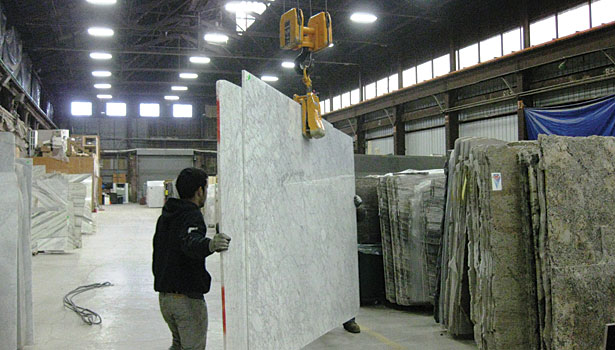Drug and alcohol abuse has reached almost epidemic proportions and has caused serious concern in the workplace, especially where machinery, trucks and heavy loads are part of the work equation. You can have the most vigorous safety awareness program in the world, but it can easily be disrupted by a single hung over employee or worker whose mental edge has been tempered by the use of drugs.
In the stone industry, both in plant and on location, the mixture of 1,000-pound slabs, forklifts, overhead cranes and drugs or alcohol is a recipe for serious injury or death. Fortunately, a survey of stone industry companies recently completed failed to uncover any serious accidents by responders because of drugs or alcohol in the recent past. Major reasons are rigid monitoring in hiring to weed out users and policies that encourage fellow employees to notify management if an associate strays from the line.
Before we focus on the results of the MIA survey, here are some additional eye-opening facts:
|
The problem is how to identify abusers. According to the National Council on Alcohol and Drug Dependence, there are some tell-tale signs: frequent financial problems, avoidance of friends and colleagues, blaming others for their own problems and shortcomings, complaints about problems at home, deterioration in personal appearance or personal hygiene and complaints, excuses and time off for vaguely defined illness or family problems.
When it comes to alcohol usage, some ominous signs include staggering or unsteady gate, mood and behavior changes such as excessive laughter and inappropriate loud talk, avoidance of supervisory contact — especially after lunch — and, of course, the smell of alcohol.
Alcohol abuse statistics are also numbing. Nearly one in 13 adults abuse alcohol or are alcoholics. Others admit to risky drinking patterns that could lead to alcohol problems. How does that impact the workplace? Absenteeism is estimated to be four to eight times greater among alcoholics and alcohol abusers. Nearly half of all traffic fatalities involve alcohol, which can be an important factor in a heavy transportation-focused industry like the stone business.
The MIA survey on drug and alcohol in the workplace indicates that members have a pretty good handle on the problem. One of the keys is to spot abusers before hiring them. A total of 55% of respondents said they do pre-hiring drug and alcohol screening, and more than half of those said they have had applicants fail the tests.
A total of 41% said they perform random or scheduled drug testing aside from that used during the hiring process and 62% reported doing post-accident testing as a follow-up to accidents in the plant, on the road or at an installation. As mentioned earlier, no respondent could identify an accident caused by an employee using alcohol or drugs.
“We do an immediate drug test on any work-related accident involving the movement of tile and stone, especially when using heavy equipment,” said one respondent.
Almost 90% of the respondents said they encourage production personnel to report suspicious drug and alcohol abuse by their fellow employees.
Alcohol and drug abuse and the consequences of using them are a frequent topic of discussion in company-wide safety meetings. “We talk about it, and reiterate that we are a drug-free company,” said one executive. “We have a whole process to go through in our policy and procedure manual,” said another.
Some companies do more than just test potential employees. “We do a background check and monitor employee behavior,” a respondent said. “We prescreen before we hire, and we conduct random drug screens throughout the year.”
What happens if an employee violates company abuse policies? Some of the respondent comments include:
• “Fire him at once.”
• “The employee is sent for testing, and if they fail the test, then it is automatic grounds for termination, as our association will not cover them on workman’s comp insurance.”
• “We advise the individual to get some sort of assistance or help.”
• “If we ever had one, he or she would be fired.”
• “If testing is determined positive, immediate dismissal.”
• “We fire them as we are a drug-free workplace. The individual is told to get help. We hold the job open only if help is sought.”
• “Dismissal. Zero tolerance.”
• “If it happens, employee will be counseled on a case by case basis.”
• “They are sent home immediately. We are a registered drug-free workplace with the State of Ohio. We have a program to follow if one of our employees is found to be on drugs that includes evaluation, counseling and retesting.”
One employer recalled an event several years ago. “I gave the individual the opportunity to get help, i.e. detox and rehab, and assured him his job was safe. He chose a different route and subsequently was fired two months later for drug abuse.”
Since many companies in the industry have just a handful of production employees, owners and managers feel they have a pretty good handle on the behavior of all employees, with whom they work closely. “We have only eight employees,” said one. “The newest has been [with us] three years. We know each other very well. We are all like family. I would know immediately if there was a problem.”
“I have a small shop and know my employees well,” said another. I’m not afraid to address what I see as an issue. I will address an employee if I see their behavior and habits change.” Bottom line consensus of respondents: You cannot reiterate your company’s drug and alcohol policies often enough. “We talk about it and reiterate that we are a drug-free company,” is a comment that speaks for most.





